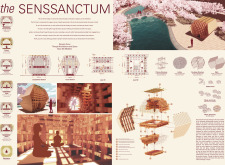5 key facts about this project
The architectural project "The Senssanctum" is a multi-functional structure designed to facilitate meditation and reflection. Situated by a serpentine waterway, it embodies a sensory experience that intertwines architectural form with natural elements. The design explores the relationship between user and environment, advocating for mindfulness and self-awareness through architecture.
The primary function of this space is to provide environments that nurture meditation practices. This is achieved through a carefully crafted arrangement of spaces that encourage communal and individual experiences. The architectural form incorporates a variety of zones, each offering a different level of intimacy, which allows users to engage with the space on their own terms.
Design Elements and Materials
The Senssanctum employs a range of materials that are thoughtfully chosen for their aesthetic and sensory qualities. The predominant use of Japanese Cedar serves both structural and olfactory purposes, creating an atmosphere that is inviting and comforting. Additionally, Japanese Cypress is utilized for its fine grain, contributing to the tactile experience of the space.
Key design details include:
- **Compression and Transition**: Visitors enter through narrow passageways that create an initial sense of compression, leading them towards larger communal areas. This transition prepares the user for a shift in scale and perception as they navigate through the structure.
- **Natural Light and Ventilation**: Strategic placement of openings allows for optimal natural light, dynamically altering the interior atmosphere throughout the day. Ventilation considerations provide fresh air circulation, enhancing comfort and focus.
- **Acoustic Design**: Attention to sound management through material choices and spatial configuration ensures a tranquil environment, making it easier for users to engage in contemplative practices without disruption.
Unique Design Approaches
What sets The Senssanctum apart from similar projects lies in its integrated sensory experience. Rather than focusing solely on visual aesthetics, the design emphasizes the activation of all five senses—sight, sound, smell, touch, and taste—through architecture.
The incorporation of wood joinery techniques underscores traditional craftsmanship while highlighting structural integrity. The combination of various wood types, including Child Joint and Metal Joint Ends, demonstrates a flexibility in construction that honors both modern methods and traditional approaches.
The layout encourages an exploration of ambient conditions, with pathways designed to guide users through varied sensory encounters. Each space’s design promotes reflection, allowing visitors to find their own experience within the context of the project.
For further details about The Senssanctum, including visual representations and architectural plans, we invite you to explore the project presentation. An examination of architectural sections and designs will provide deeper insights into the innovative concepts underlying this project.























